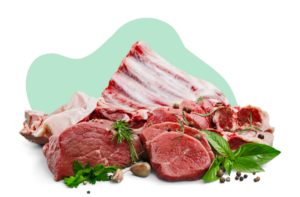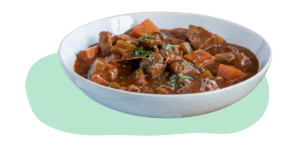Contents
- Meat and fish
- Seasonal vegetables
- Herbs and spices
- Take the pressure off with Hey Fresto!’s stew range
Stew is timeless, a meal which dates all the way back to the Jōmon period between 14,000 – 300 BCE and one which is still thoroughly enjoyed by people across the world today.
Its variations are infinite, a dish shared by many cultures and communities around the world and because of this, it has many forms, flavours and fillings.
From the Guyanese pepperpot, a meal made from evaporated cassava juice, fish, small game, crushed bones and peppers, to the Hungarian főzelék, a pottage-like dish made with marrow, stews are a comforting, traditional and globally-appreciated staple.
And when is there a better time to consume such a heart-warming meal than autumn, a period defined by cold snaps and dwindling daylight.
So without further ado, let’s discover how to make the perfect autumnal stew.
Meat and fish
Throughout history, stew was a dish that represented much more than a solution to hunger.
According to The Oxford Handbook of Food History, the serving and eating of chankonabe was a way of illustrating the ranking system of Japanese sumo wrestlers.
Traditionally, chankonabe was consumed by high-ranking wrestlers first, leaving the stragglers to finish the few bits of meat and vegetables left.
Irish stew was also a meal with purpose, a way of eating up old sheep that could no longer be farmed for wool or milk.
So, in an age where stew is an indulgence rather than a necessity, and the choice of ingredients far more varied and accessible, it can be difficult to know where to start.
If you fancy a stew that includes meat like beef, lamb or pork, choosing a cut with lots of collagen in it is preferable according to food writer Daniel Gritzer.
This is because after a long period of cooking, the once tough meat adopts that desirable ‘melt-in-the-mouth’ texture which home cooks dream of.
Good meat cuts for your stews include the oxtail, chuck and brisket of beef, the shoulder, ribs, tenderloin or leg for pork and the leg, shoulder or neck for lamb.
For those of you wanting to pack as much omega-3 in your autumnal stew as possible, it’s important to select a seafood that won’t leave you with a dry or worse, mushy, monstrosity.
Large pieces of cod, halibut, hake, salmon or shellfish like crab and lobster are good choices which work well with herbs like dill and
Seasonal vegetables
Vegetables, whether the star or the sidekick, are crucial to making a stew sing.
With autumn underway, there are plenty of suitable seasonal vegetables to choose from – turnips, carrots, swede and other root veggies are ideal for stews as they can withstand longer cooking temperatures.
And even if you’re not a veggie-lover, they are important to include in stews for extra goodness.
Carrots, butternut squash and pumpkins are good sources of beta carotene and vitamin A which help support the immune system; swedes provide a great source of fibre, glucosinolates, vitamins C and E as well as potassium, magnesium and calcium, and leeks contain vitamin K1 which benefits heart health and helps blood clots to form.
Health benefits and flavour aside, seasonal vegetables are a brilliant way to bring down the cost of your stew, a must amid the current economic climate.
This can be achieved by substituting legumes and pulses for meat too, ingredients which have been a part of stew recipes since their inception.
If you’re struggling for inspiration, simple stew recipes such as Tuscan ribollita or Turkish kuru fasulye are bean-bountiful dishes to begin with.
Herbs and spices
Herbs and spices are your flavour enhancers where a stew is concerned and will elevate the eating experience of meat cuts and vegetables.
They are also a great way to reduce your salt consumption – stock already has a high salt content so using herbs and spices instead of adding more sodium chloride is preferable to make the stew healthier.
The next step is deciphering the best seasoning pairings.
Here are some recommended herbs and spices to match with your meats.
Chicken
Herbs: basil, rosemary, chives, sage, dill, mint, oregano, bay leaves, parsley, chervil, tarragon, thyme and coriander.
Spices: cayenne pepper, cumin, cinnamon, smoked paprika and cloves.
Lamb
Herbs: za’atar, chervil, rosemary, basil, sage, basil, thyme and oregano.
Spices: mustard powder, chilli powder, cumin and sumac, garam masala and cardamom.
Beef
Herbs: sage, rosemary, thyme and parsley.
Spices: mustard powder, cumin, Chinese five spice, chilli powder, cayenne peppers and smoked paprika.
Pork
Herbs: parsley, thyme, dill, rosemary and tarragon.
Spices: cinnamon, Chinese five spice, star anise, cumin, chilli powder and ginger.
Goat
Herbs: za’atar, parsley, fennel, rosemary, parsley, thyme and mint.
Spices: garam masala, chilli powder, ground pimento and cardamom.
Duck
Herbs: thyme, basil, sage, za’atar, lemongrass and rosemary.
Spices: ginger, star anise, Chinese five spice, cinnamon, chilli, cumin and paprika.
Fish
Herbs: sage, parsley, dill and chives.
Spices: cumin, ginger and turmeric.
Take the pressure off with Hey Fresto!’s stew range
If you’d rather enjoy the rich indulgence of a stew quickly instead of spending hours at your stove eating for the magic to happen then why not try Hey Fresto!’s selection?
From a luxurious beef and red wine stew to our seriously smoky Catalan style chicken and chorizo stew, we’ve got your autumn evenings covered.




